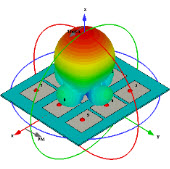HFSS vs. CST
05-08
Experts,
> Are there any benchmarks that compare the performance between
>HFSS and CST available?
>
I'm not aware of any public document that does that. However, I'm
certain many users have made independent evaluation of the two tools for
specific applications of their interest. The evaluation reports are
usually not published in the public domain due to confidentiality and
even legal reasons.
> In going from a frequency domain solver to a time domain solver
>and vise versa what are the trade offs?
>
Let's be specific here and consider CST Microwave Studio as the time
domain solver and Ansoft HFSS as the frequency domain solver. (BTW,
"CST" and "Ansoft" are company names, and "Microwave Studio" (MWS) and
"High Frequency Structure Simulator" (HFSS) are the names of the 3D
electromagnetic field solvers).
MWS solves for transient (time-domain) electric field (E) directly
(natively). That is, it directly solves for electric field in a 3D
space as a function of time. It then indirectly, through Maxwell's
equations, solves for magnetic field (H) as a function of time. Once E
and H are known, many other related parameters (such as current
distribution), can be computed (indirectly). Frequency domain
parameters are indirectly obtained through Fourier transformation.
HFSS solves natively for E field as a function of frequency. H field is
indirectly obtained through Maxwell's equations. Other related
parameters are indirectly computed just like in MWS. Time-domain
parameter are indirectly obtained through inverse Fourier transformation.
The keywords you need to observe from my two paragraphs above are
"direct" and "indirect". Anything computed directly is "potentially"
more accurate than the one computed indirectly. Therefore, transient
parameters computed by MWS are "potentially" more accurate than
transient parameters computed by HFSS. Likewise, frequency-domain
parameters computed by HFSS are "potentially" more accurate than
frequency-domain parameters computed by MWS. You have to meet certain
Fourier transform conditions to obtain accurate results when you change
parameters from one domain to the other. In most cases the conditions
are hard to meet thereby limiting the accuracy.
Any one field component, E or H, can be used for S-parameter
computation. However, the two tools differ slightly in the way they
compute S-parameters. MWS would need to solve the problem as many times
as the number of ports to obtain all S-parameters, while HFSS solves the
problem only once to obtain all the S-parameters. For high port count,
MWS can potentially be much slower than HFSS due to this reason.
For frequency-domain S-parameters to be valid, MWS requires the field at
each port to settle to a particular (specified) level. The smaller the
level the longer the simulation. The field in high Q structures take
extremely long to die off. Such structures may take very long to solve
using MWS transient solver.
MWS uses a time stepping algorithm. That is, it solves for E field one
time step at a time. Once all the time domain E field is computed, the
fields at all frequencies are computed at once. On the other hand, HFSS
solves for E field one frequency at a time. If you need time-domain
results, you will have to solve for many frequencies. It offers at least
two ways of obtaining fast frequency domain results : Fast Sweep and
Interpolating Sweep. They are both "interpolating" schemes hence
introduce their own errors. Generally you cannot really tell which tool
will be faster in producing broadband results of a particular structure.
Neither can you tell which one will be more accurate in that case.
However, for narrowband, you are certainly better off with HFSS.
The other issue is about scaling. Bigger size problem needs longer time
to settle, which leads to longer MWS simulation time even for narrowband
solution. Bigger problems also demand more memory and MWS, being a
Windows software, can't solve problems requiring more than 2GB of
memory. With HFSS, bigger size problems also means huge matrices to
solve, and very long simulation time. In memory terms, HFSS is better as
it can run on UNIX and use up to 8GB of memory (or more).
> Is accuracy of the HFSS and CST at the same level?
>
This is a very important question! When I evaluate a tool I don't only
check whether the tool is accurate, rather I check if it is
*consistently accurate*. I like the tool to be predictable. When I use
the tool to model a number of known structures I expect it to
consistently give accurate results - for all the structures, all the time.
Both MWS and HFSS can be setup to yield accurate results but the effort
needed to achieve that differs considerably between the two tools.
> Is there any type of problem that will not be accurate with one
>or the other?
>
>
Frequency-dependent loss is not handled well by MWS. However, you can do
more kinds of analyses with MWS than HFSS. For example,TDR analysis with
NRZ waveform.
> Are there any benchmarks that compare the performance between
>HFSS and CST available?
>
I'm not aware of any public document that does that. However, I'm
certain many users have made independent evaluation of the two tools for
specific applications of their interest. The evaluation reports are
usually not published in the public domain due to confidentiality and
even legal reasons.
> In going from a frequency domain solver to a time domain solver
>and vise versa what are the trade offs?
>
Let's be specific here and consider CST Microwave Studio as the time
domain solver and Ansoft HFSS as the frequency domain solver. (BTW,
"CST" and "Ansoft" are company names, and "Microwave Studio" (MWS) and
"High Frequency Structure Simulator" (HFSS) are the names of the 3D
electromagnetic field solvers).
MWS solves for transient (time-domain) electric field (E) directly
(natively). That is, it directly solves for electric field in a 3D
space as a function of time. It then indirectly, through Maxwell's
equations, solves for magnetic field (H) as a function of time. Once E
and H are known, many other related parameters (such as current
distribution), can be computed (indirectly). Frequency domain
parameters are indirectly obtained through Fourier transformation.
HFSS solves natively for E field as a function of frequency. H field is
indirectly obtained through Maxwell's equations. Other related
parameters are indirectly computed just like in MWS. Time-domain
parameter are indirectly obtained through inverse Fourier transformation.
The keywords you need to observe from my two paragraphs above are
"direct" and "indirect". Anything computed directly is "potentially"
more accurate than the one computed indirectly. Therefore, transient
parameters computed by MWS are "potentially" more accurate than
transient parameters computed by HFSS. Likewise, frequency-domain
parameters computed by HFSS are "potentially" more accurate than
frequency-domain parameters computed by MWS. You have to meet certain
Fourier transform conditions to obtain accurate results when you change
parameters from one domain to the other. In most cases the conditions
are hard to meet thereby limiting the accuracy.
Any one field component, E or H, can be used for S-parameter
computation. However, the two tools differ slightly in the way they
compute S-parameters. MWS would need to solve the problem as many times
as the number of ports to obtain all S-parameters, while HFSS solves the
problem only once to obtain all the S-parameters. For high port count,
MWS can potentially be much slower than HFSS due to this reason.
For frequency-domain S-parameters to be valid, MWS requires the field at
each port to settle to a particular (specified) level. The smaller the
level the longer the simulation. The field in high Q structures take
extremely long to die off. Such structures may take very long to solve
using MWS transient solver.
MWS uses a time stepping algorithm. That is, it solves for E field one
time step at a time. Once all the time domain E field is computed, the
fields at all frequencies are computed at once. On the other hand, HFSS
solves for E field one frequency at a time. If you need time-domain
results, you will have to solve for many frequencies. It offers at least
two ways of obtaining fast frequency domain results : Fast Sweep and
Interpolating Sweep. They are both "interpolating" schemes hence
introduce their own errors. Generally you cannot really tell which tool
will be faster in producing broadband results of a particular structure.
Neither can you tell which one will be more accurate in that case.
However, for narrowband, you are certainly better off with HFSS.
The other issue is about scaling. Bigger size problem needs longer time
to settle, which leads to longer MWS simulation time even for narrowband
solution. Bigger problems also demand more memory and MWS, being a
Windows software, can't solve problems requiring more than 2GB of
memory. With HFSS, bigger size problems also means huge matrices to
solve, and very long simulation time. In memory terms, HFSS is better as
it can run on UNIX and use up to 8GB of memory (or more).
> Is accuracy of the HFSS and CST at the same level?
>
This is a very important question! When I evaluate a tool I don't only
check whether the tool is accurate, rather I check if it is
*consistently accurate*. I like the tool to be predictable. When I use
the tool to model a number of known structures I expect it to
consistently give accurate results - for all the structures, all the time.
Both MWS and HFSS can be setup to yield accurate results but the effort
needed to achieve that differs considerably between the two tools.
> Is there any type of problem that will not be accurate with one
>or the other?
>
>
Frequency-dependent loss is not handled well by MWS. However, you can do
more kinds of analyses with MWS than HFSS. For example,TDR analysis with
NRZ waveform.
全英文,,,,,,,,,,,,,,,,,,,,,,,,,,,,,,太难搞懂
:19de :19de :19de :19de
好,收藏了,谢谢!
还是略微倾向CST的,但俺还是对CST使用者的水平表示怀疑,N多使用者并不懂收敛分析,得不到正确解(MWS的自适应收敛相当弱)。这一点上HFSS要好得多,但这一点是“专家”不会顾及的。
支持CST呵呵...
:29bb :15de
那就来给大家答疑解惑嘛。。
支持cst!
5555555555555讨厌的英文 看不懂
满头雾水 看不懂。
CST到底有什么好?
偶米学过英文,I don't understand
偶怎么感觉是偏向HFSS的?其实各有所长啦,记得论坛里有一篇3维仿真软件的趋势写得挺好的
相关文章:
- HFSS功能的详细叙述(05-08)
- HFSS收敛(Convergence)问题(05-08)
- HFSS的在当今世界的广泛应用及其日益发展的巨大潜力(05-08)
- HFSS V9.2的帮助文件部分翻译(05-08)
- HFSS软件简单介绍(05-08)
- HFSS和Q3D的区别(05-08)
射频专业培训教程推荐











